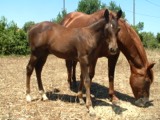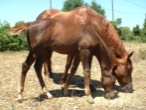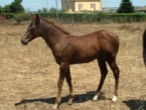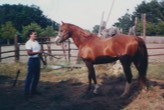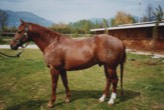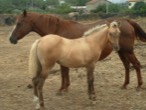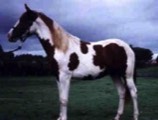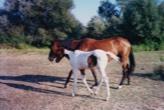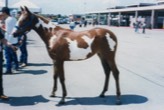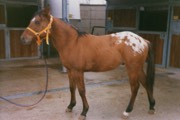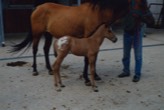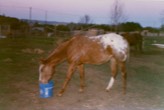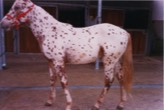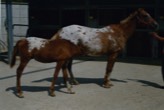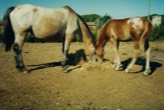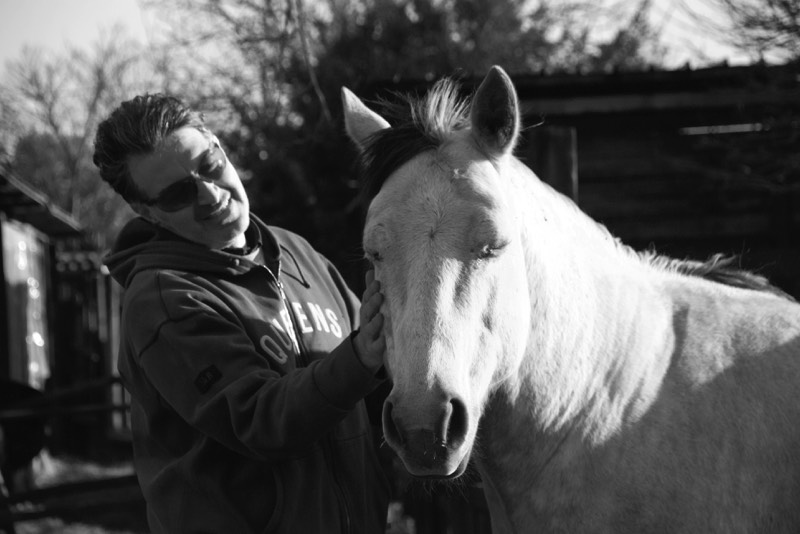
A qualcuno sembrerà strano trovare questa pagina all'interno di un sito sul Cane Corso.
In realtà, a coniugare le due cose, non è soltanto la passione di chi scrive ma il forte richiamo che anche i cavalli, da sempre coadiutori degli uomini nelle loro attività rurali, esprimono.
Ed in particolare le razze qui trattate, Appaloosa, Paint e Quarter, rappresentano nel mondo equino quei cavalli forti, resistenti e a loro modo “rustici”, quindi più vicini ed adatti alle quotidiane attività dell'uomo.
Some may find this strange page within a site on the Cane Corso.
In fact, to combine the two things, it is not only the passion of the writer but also the strong appeal that horses always coadjutor of men in their rural activities, express themselves.
And in particular breeds discussed here, Appaloosa, Paint and Quarter, are those horses in the equine world strong, resilient, and in their way "rustic", then closer and adapted to everyday human activities.
QUARTER HORSE
Si pensa che la razza abbia avuto origine nelle colonie americane della Carolina e della Virginia nel secolo XVII. Veniva usata per correre su un rettilineo di circa un quarto di miglio (400m) e per una distanza così breve, era fondamentale una partenza scattante e il raggiungimento della massima velocità in un tempo brevissimo.
Ai fini di tale selezione vennero incrociate razze locali con il puro sangue inglese.
Ha avuto grande diffusione nei ranch, dove le sue caratteristiche lo rendono ideale per il lavoro dei mandriani ed è attualmente largamente utilizzato nei rodei e in altre esibizioni.
E' il cavallo ideale per il tempo libero: di ottimo carattere, robusto ed economico nel mantenimento. Docile ma vivace, versatile, forte ed energico, dotato di grande equilibrio psichico, consolidato ereditariamente tramite l'allevamento selettivo finalizzato a sviluppare eccellenti doti di affinità e di dimestichezza con l'uomo. Per quanto calmo e docile, il Quarter ha un elevato grado di nevrilità che si esprime quando è sollecitata l'azione (vedi gare di Barrel e Pole). Questa caratteristica, determinante per l'equitazione da tempo libero si spiega solo con l'allevamento selettivo ai fini del pesante lavoro quotidiano con i cowboy, al quale la razza è sottoposta da secoli.
Ha corpo relativamente corto e massiccio, muscolatura particolarmente evidente nel dorso e nella groppa, quarti posteriori possenti Le dimensioni medie variano da 1,47 a 1,57 m di altezza al garrese, ma possono arrivare anche a 1,65 m.
Il mantello può essere di qualunque colore ma uniforme. I pezzati non sono ammessi e i cavalli con marcature bianche non possono essere registrati nel Libro genealogico.
Si pensa che la razza abbia avuto origine nelle colonie americane della Carolina e della Virginia nel secolo XVII. Veniva usata per correre su un rettilineo di circa un quarto di miglio (400m) e per una distanza così breve, era fondamentale una partenza scattante e il raggiungimento della massima velocità in un tempo brevissimo.
Ai fini di tale selezione vennero incrociate razze locali con il puro sangue inglese.
Ha avuto grande diffusione nei ranch, dove le sue caratteristiche lo rendono ideale per il lavoro dei mandriani ed è attualmente largamente utilizzato nei rodei e in altre esibizioni.
E' il cavallo ideale per il tempo libero: di ottimo carattere, robusto ed economico nel mantenimento. Docile ma vivace, versatile, forte ed energico, dotato di grande equilibrio psichico, consolidato ereditariamente tramite l'allevamento selettivo finalizzato a sviluppare eccellenti doti di affinità e di dimestichezza con l'uomo. Per quanto calmo e docile, il Quarter ha un elevato grado di nevrilità che si esprime quando è sollecitata l'azione (vedi gare di Barrel e Pole). Questa caratteristica, determinante per l'equitazione da tempo libero si spiega solo con l'allevamento selettivo ai fini del pesante lavoro quotidiano con i cowboy, al quale la razza è sottoposta da secoli.
Ha corpo relativamente corto e massiccio, muscolatura particolarmente evidente nel dorso e nella groppa, quarti posteriori possenti Le dimensioni medie variano da 1,47 a 1,57 m di altezza al garrese, ma possono arrivare anche a 1,65 m.
Il mantello può essere di qualunque colore ma uniforme. I pezzati non sono ammessi e i cavalli con marcature bianche non possono essere registrati nel Libro genealogico.
QUARTER HORSE
It is believed that the breed to have originated in the American colonies of Carolina and Virginia in the seventeenth century. It was used to run in a straight line about a quarter of a mile (400m) and for a distance so short, it was a fundamental departure snappy and the achievement of maximum speed in a very short time.
For the purposes of this selection were crossed with local breeds pure English blood.
It has had widespread use in the ranch, where its characteristics make it ideal for the job of herdsmen and is currently widely used in rodeos and other exhibitions.
E 'the ideal horse for leisure: excellent character, strong and economical maintenance. Docile but lively, versatile, strong and energetic, with great mental balance, consolidated by heredity through selective breeding aimed at developing excellent qualities of affinity and familiarity with man. As calm and docile, the Quarter has a high degree of nevrilit which expresses itself when it urged action (see Barrel racing and Pole). This feature, which is decisive for riding from leisure can only be explained by selective breeding for the purpose of heavy daily work with the Cowboys in which the race is subjected for centuries.
It has relatively short and massive body, muscles particularly evident in the trunk and back, powerful hindquarters The average size ranging from 1.47 to 1.57 m in height at the withers, but they can also reach 1.65 m.
The coat can be of any color but uniform. The piebald are not allowed and the horses with white markings can not be registered in the Herd Book.
It is believed that the breed to have originated in the American colonies of Carolina and Virginia in the seventeenth century. It was used to run in a straight line about a quarter of a mile (400m) and for a distance so short, it was a fundamental departure snappy and the achievement of maximum speed in a very short time.
For the purposes of this selection were crossed with local breeds pure English blood.
It has had widespread use in the ranch, where its characteristics make it ideal for the job of herdsmen and is currently widely used in rodeos and other exhibitions.
E 'the ideal horse for leisure: excellent character, strong and economical maintenance. Docile but lively, versatile, strong and energetic, with great mental balance, consolidated by heredity through selective breeding aimed at developing excellent qualities of affinity and familiarity with man. As calm and docile, the Quarter has a high degree of nevrilit which expresses itself when it urged action (see Barrel racing and Pole). This feature, which is decisive for riding from leisure can only be explained by selective breeding for the purpose of heavy daily work with the Cowboys in which the race is subjected for centuries.
It has relatively short and massive body, muscles particularly evident in the trunk and back, powerful hindquarters The average size ranging from 1.47 to 1.57 m in height at the withers, but they can also reach 1.65 m.
The coat can be of any color but uniform. The piebald are not allowed and the horses with white markings can not be registered in the Herd Book.
PAINT
Selezionato per la prima volta dagli indiani Comanches era da loro apprezzato prevalentemente per la sua vivacità, robustezza e agilità. In origine, come il Palomini, anche il Pinto veniva registrato come un colore piuttosto che una vera razza. Oggi, la definizione copre quattro diverse tipologie. Negli USA i Pinto vengono suddivisi in tre distinti registri:
L'American Paint Horse Registry per cavalli tipo Stock Horse, di discendenza Quarter o Purosangue. -
Il Pinto Registry per cavalli tipo Stock Horse, Hunter e sella. -
La Moroccan Spotted Horse Cooperative Association per cavalli ambiatori e discendenza Araba, Americano da Sella, Purosangue, Morgan, Tennessee Walking Horse e Hackney. .
Cavallo da sella e tiro leggero, particolarmente indicato per il galoppo, la sua versatilità lo rende idoneo a tutte le specialità equestri.
Cavallo di interesse internazionale.è diffuso in America e in Europa. L'allevamento di stalloni Paint è molto apprezzato nel nostro paese e negli ultimi anni l'Italia ha ottenuto, nell'ambito dei campionati americani di morfologia, ottimi risultati
Molto robusto, deve avere una testa ben proporzionata, a profilo rettilineo, con faccia larga e orecchie non piccole o affusolate, il collo deve essere muscoloso, il garrese rilevato, la groppa arrotondata e la coda ben attaccata e il torace ampio e profondo. Gli arti devono risultare solidi e muscolosi, piuttosto corti con articolazioni e tendini resistenti e infine zoccolo arrotondato.
Selezionato per la prima volta dagli indiani Comanches era da loro apprezzato prevalentemente per la sua vivacità, robustezza e agilità. In origine, come il Palomini, anche il Pinto veniva registrato come un colore piuttosto che una vera razza. Oggi, la definizione copre quattro diverse tipologie. Negli USA i Pinto vengono suddivisi in tre distinti registri:
L'American Paint Horse Registry per cavalli tipo Stock Horse, di discendenza Quarter o Purosangue. -
Il Pinto Registry per cavalli tipo Stock Horse, Hunter e sella. -
La Moroccan Spotted Horse Cooperative Association per cavalli ambiatori e discendenza Araba, Americano da Sella, Purosangue, Morgan, Tennessee Walking Horse e Hackney. .
Cavallo da sella e tiro leggero, particolarmente indicato per il galoppo, la sua versatilità lo rende idoneo a tutte le specialità equestri.
Cavallo di interesse internazionale.è diffuso in America e in Europa. L'allevamento di stalloni Paint è molto apprezzato nel nostro paese e negli ultimi anni l'Italia ha ottenuto, nell'ambito dei campionati americani di morfologia, ottimi risultati
Molto robusto, deve avere una testa ben proporzionata, a profilo rettilineo, con faccia larga e orecchie non piccole o affusolate, il collo deve essere muscoloso, il garrese rilevato, la groppa arrotondata e la coda ben attaccata e il torace ampio e profondo. Gli arti devono risultare solidi e muscolosi, piuttosto corti con articolazioni e tendini resistenti e infine zoccolo arrotondato.
PAINT
Selected for the first time by the Indians from their Comanches was appreciated mainly for its liveliness, strength and agility. Originally, as the Palomini, the Pinto was also registered as a color rather than a true race. Today, the definition covers four different types. In the USA, Pinto are divided into three distinct registers:
The American Paint Horse Registry Horse type Stock Horse, Thoroughbred or Quarter of descent. -
The Pinto Horse Registry Horse Stock type, Hunter and saddle. -
The Moroccan Association for Cooperative Spotted Horse horses ambiatori and Arab descent, American Saddle, Thoroughbred, Morgan, Tennessee Walking Horse, and Hackney. .
Horse riding and shooting light, particularly suitable for the gallop, its versatility makes it suitable for all equestrian specialties.
Horse internazionale.è widespread interest in America and in Europe. The breeding stallions Paint is much appreciated in our country and in recent years Italy has obtained, under the American championships in morphology, excellent results
Very strong, it must have a well-proportioned head, straight profile, with a broad face and ears small and slender, the neck should be muscular, the withers detected, the rounded rump and tail firmly attached and the chest wide and deep. The legs should be strong and muscular, rather short with joints and tendons resistant and finally rounded base.
Selected for the first time by the Indians from their Comanches was appreciated mainly for its liveliness, strength and agility. Originally, as the Palomini, the Pinto was also registered as a color rather than a true race. Today, the definition covers four different types. In the USA, Pinto are divided into three distinct registers:
The American Paint Horse Registry Horse type Stock Horse, Thoroughbred or Quarter of descent. -
The Pinto Horse Registry Horse Stock type, Hunter and saddle. -
The Moroccan Association for Cooperative Spotted Horse horses ambiatori and Arab descent, American Saddle, Thoroughbred, Morgan, Tennessee Walking Horse, and Hackney. .
Horse riding and shooting light, particularly suitable for the gallop, its versatility makes it suitable for all equestrian specialties.
Horse internazionale.è widespread interest in America and in Europe. The breeding stallions Paint is much appreciated in our country and in recent years Italy has obtained, under the American championships in morphology, excellent results
Very strong, it must have a well-proportioned head, straight profile, with a broad face and ears small and slender, the neck should be muscular, the withers detected, the rounded rump and tail firmly attached and the chest wide and deep. The legs should be strong and muscular, rather short with joints and tendons resistant and finally rounded base.
APPALOOSA
I primi allevatori degli Appaloosa furono gli indiani Nez Percé (Nasi Forati). Una tribù pacifica che viveva nei territori dell'attuale Idaho, lungo le sponde del fiume Palouse, dal quale la razza stessa prende il nome. Selezionarono questa razza docile ed equilibrata ma dotata di forza e resistenza eccezionale. Verso la metà del secolo scorso però i rapporti dei Nez Percé con i bianchi si deteriorarono: a causa della presenza di alcuni giacimenti nel territorio della tribù.
I bianchi intimarono ai Nasi Forati di spostarsi immediatamente all'interno di una riserva senza considerare che, il rispetto della richiesta da parte degli indiani, avrebbe comportato l'attraversamento del fiume Snake River in piena primaverile. I cavalli più forti riuscirono a passare e a portare in salvo i componenti più deboli della tribù ed i loro beni ma gran parte della mandria ebbe la peggio.
Questo episodio scatenò l'ira degli indiani, fino ad allora pacifici, nei confronti dei bianchi. I più giovani si vendicarono ed in conseguenza di ciò la tribù dovette fuggire. Questo popolo non guerriero, con in testa Capo Giuseppe ed in sella ai loro Appaloosa percorse 2500 chilometri alla volta del Canada, tenendo testa all'esercito americano e sconfiggendolo per ben sei volte, fino a quando non dovette arrendersi alla superiorità numerica e militare degli americani.
Il manto degli Appaloosa può essere: Leopard (bianco con macchie scure); Snowflake(baio o scuro con macchie bianche); Solid (tinta unita). L'unico mantello non ammesso è quello albino.
Ed è strano perché sembra che la razza abbia avuto origine da una femmina albina appartenuta alla tribù Shoshoni ed affidata alle cure dei Nez Percé, che avrebbe partorito un puledro maschio.Dai successivi accoppiamenti dei due avrebbe avuto origine la razza.
Per esattezza cito alcune prestigiosissime genealogie utilizzate durante il mio percorso: Genuine Redskin, Little Peppy, Frosen Sailor.
I primi allevatori degli Appaloosa furono gli indiani Nez Percé (Nasi Forati). Una tribù pacifica che viveva nei territori dell'attuale Idaho, lungo le sponde del fiume Palouse, dal quale la razza stessa prende il nome. Selezionarono questa razza docile ed equilibrata ma dotata di forza e resistenza eccezionale. Verso la metà del secolo scorso però i rapporti dei Nez Percé con i bianchi si deteriorarono: a causa della presenza di alcuni giacimenti nel territorio della tribù.
I bianchi intimarono ai Nasi Forati di spostarsi immediatamente all'interno di una riserva senza considerare che, il rispetto della richiesta da parte degli indiani, avrebbe comportato l'attraversamento del fiume Snake River in piena primaverile. I cavalli più forti riuscirono a passare e a portare in salvo i componenti più deboli della tribù ed i loro beni ma gran parte della mandria ebbe la peggio.
Questo episodio scatenò l'ira degli indiani, fino ad allora pacifici, nei confronti dei bianchi. I più giovani si vendicarono ed in conseguenza di ciò la tribù dovette fuggire. Questo popolo non guerriero, con in testa Capo Giuseppe ed in sella ai loro Appaloosa percorse 2500 chilometri alla volta del Canada, tenendo testa all'esercito americano e sconfiggendolo per ben sei volte, fino a quando non dovette arrendersi alla superiorità numerica e militare degli americani.
Il manto degli Appaloosa può essere: Leopard (bianco con macchie scure); Snowflake(baio o scuro con macchie bianche); Solid (tinta unita). L'unico mantello non ammesso è quello albino.
Ed è strano perché sembra che la razza abbia avuto origine da una femmina albina appartenuta alla tribù Shoshoni ed affidata alle cure dei Nez Percé, che avrebbe partorito un puledro maschio.Dai successivi accoppiamenti dei due avrebbe avuto origine la razza.
Per esattezza cito alcune prestigiosissime genealogie utilizzate durante il mio percorso: Genuine Redskin, Little Peppy, Frosen Sailor.
APPALOOSA
The first breeders of the Appaloosa were the Nez Perce Indians (Nez Perce). A peaceful tribe who lived in the territories of Idaho, along the banks of the Palouse River, from which the breed gets its name. They selected this breed docile and balanced but with exceptional strength and endurance. Towards the middle of the last century, however, the ratios of the Nez Percé with whites deteriorated: Due to the presence of some deposits in the territory of the tribe.
The white intimated to the Nez Perce to move immediately into a reserve without considering that, in respect of the request by the Indians, would have resulted in the crossing of the River Snake River in full spring. The horses were able to pass the strongest and rescue the weaker members of the tribe and their goods, but most of the herd had the worst.
This incident sparked the ire of the Indians, hitherto peaceful towards the whites. The younger retaliated and in consequence of what the tribe was forced to flee. These people are not warrior, led by Chief Joseph and riding their Appaloosa traveled 2500 kilometers for Canada, taking the head to the American army and defeating him six times, until it had to surrender to the numerical superiority of the American military and .
The coat of the Appaloosa can be: Leopard (white with brown spots); Snowflake (or dark bay horse with white spots); Solid (solid). The single coat is not allowed albino.
And it's strange because it seems that the breed to have originated from a female albino belonged to the Shoshone tribe and entrusted to the care of the Nez Percé, who would give birth to a foal maschio.Dai successive pairs of them would have originated the breed.
For accuracy I quote some very prestigious pedigrees used during my career: Genuine Redskin, Little Peppy, Frosen Sailor.
The first breeders of the Appaloosa were the Nez Perce Indians (Nez Perce). A peaceful tribe who lived in the territories of Idaho, along the banks of the Palouse River, from which the breed gets its name. They selected this breed docile and balanced but with exceptional strength and endurance. Towards the middle of the last century, however, the ratios of the Nez Percé with whites deteriorated: Due to the presence of some deposits in the territory of the tribe.
The white intimated to the Nez Perce to move immediately into a reserve without considering that, in respect of the request by the Indians, would have resulted in the crossing of the River Snake River in full spring. The horses were able to pass the strongest and rescue the weaker members of the tribe and their goods, but most of the herd had the worst.
This incident sparked the ire of the Indians, hitherto peaceful towards the whites. The younger retaliated and in consequence of what the tribe was forced to flee. These people are not warrior, led by Chief Joseph and riding their Appaloosa traveled 2500 kilometers for Canada, taking the head to the American army and defeating him six times, until it had to surrender to the numerical superiority of the American military and .
The coat of the Appaloosa can be: Leopard (white with brown spots); Snowflake (or dark bay horse with white spots); Solid (solid). The single coat is not allowed albino.
And it's strange because it seems that the breed to have originated from a female albino belonged to the Shoshone tribe and entrusted to the care of the Nez Percé, who would give birth to a foal maschio.Dai successive pairs of them would have originated the breed.
For accuracy I quote some very prestigious pedigrees used during my career: Genuine Redskin, Little Peppy, Frosen Sailor.
